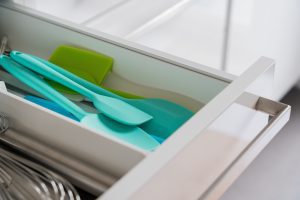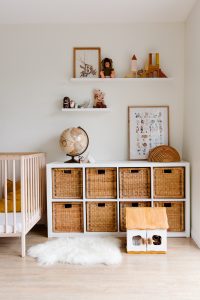I found myself completely overwhelmed in my own house by all the stuff we had everywhere. I was tired of our kitchen becoming a dump zone, a trashed playroom causing the toys to overflow into the living room, and truly always feeling behind on cleaning. It felt so debilitating. I knew I needed to clean and organize to feel more liberated from the rut I was in, but I couldn’t even fathom starting until I came across The Home Edit. The Home Edit started as an Instagram, has published two books (available to check out at the library), and just released its second season on Netflix. Desperate to get started with my first room, the kitchen, I found a kitchen organizing episode and sat on the couch to watch it. Finally, I had enough inspiration to get started. Here are the lessons I’ve learned on my home editing journey:
Start Small:
Evaluate how much time you really have to start and complete a project. It may just be one hour today but an entire Saturday next weekend. Then be realistic with what you can organize in that time frame. Don’t start your pantry (a large project) if you only have 1 hour to complete it. Instead, opt for something smaller like the junk drawer that you know you can do from start to finish to give you the motivation to continue.
Side note: The Home Edit says it’s ok to have a junk drawer in your kitchen as long as it’s organized and everything has a place. However, knowing my family, I opted to get rid of our junk drawer entirely in our kitchen edit and now things actually go where they are supposed to!

Editing:
Step one of their process is known as editing. This means creating three piles: keep, donate, and throw. I knew there were items in the kitchen I had not used in a long time – food spiralizer, and who needs two garlic presses? I likely wouldn’t use these in the future and I was ready to start getting rid of stuff. This process holds true for every area you organize and edit. It is best done when everything is taken out of each shelf and then purposefully placed back. Hence needing the time to really complete each space, and yes it will get very messy during the process.
Speaking of editing, even kids can edit. During Season 2 Episode 4, they gave examples of how to get kids involved, like pointing out that they’ll have space for new stuff or turning it into a game of keep or toss and going through items as quickly as possible. The quicker the process, the less time they have to really think about their decision.
Zones:
Another important process is identifying the goal of each room. Is it to create more counter space in your kitchen? Do you need a coffee station? What hobbies do you have that you would like to see reflected in your personal space? Do you need a make-up station or gift wrapping area in a closet? Identify what it is you would like to see in the room you are organizing and have a general layout in mind. This will help both in editing your space, and also determining what your priorities are in organizing.
Creating a zone also gets rid of a space acting as a multipurpose area. For example, when I was organizing my kids’ closet, I knew I wanted their clothes to hang, extra diaper supplies stored, and extra bedsheets. I went through the clothes and got rid of all winter items and anything in the closet that wasn’t specifically aligned with the goals I had – hello candles and old toys. It also avoids this being a future dump zone, but yes, this meant I needed to find a new home for the candles.

Contain:
Another key element to what The Home Edit lives by is to contain everything in containers of sorts before it goes back onto a shelf. The Home Edit has a product line at The Container Store, the nearest location being in Texas. The price tag of The Container Store was not something I was on board with in terms of home editing my entire house. They generally use clear bins so you can easily identify what is in each one and also holds you more accountable to correctly return items. However, you can also use the clean look of white plastic bins, hyacinth or rattan baskets, or even firm storage cubes. The key to containers is that whatever you use in one designated space stays consistent throughout to achieve a nice, clean, organized look. On the search for a cheaper alternative, I came across the Target Bright room brand. With items ranging from $2 to $15, I found this much more affordable. They still have clear stackable bins, bins with lids (I used on our medicine cabinet), turntables (great for corners of rooms so you can still visually see everything without taking stuff out of a shelf), and even some containers with drawers. Another key to containers is while you may be searching for a kitchen item, you might find the perfect storage solution under the bathroom category. And rattan style baskets are typically under the furniture section of stores. Bins allow you to use the entire depth of a shelf without having to unstack everything that might be in front. Simply, pull the one bin down, browse through and place the entire bin back on the shelf with everything still neatly organized.
80/20 Rule, Line, and Label:
As you begin to put items back, only fill each shelf 80% of the way. This allows space between bins so there is no rubbing or potential for two bins to come crashing down at once. It also allows you a little space to add as our lives change constantly. Both in horizontal space as well as vertical space.
Line up all your bins with equal spaced distance apart, and if there are multiple levels to your shelving, have the bins line up vertically as well. This creates the clean and uniform aesthetic seen in all their Instagram pictures. If you have items like spices that have color, you can create a rainbow effect by organizing them by color to add another aesthetic element to your organization. Generally, everyone knows paprika is red, and pepper is black. They often do this in areas like kids’ books or board games as well, as children often associate color with items yet can easily identify where it should be placed back in the lineup (versus sorting by theme or alphabetically).
Labeling completes the look. Keep the labels uniform and as specific yet broad as you can. For example, label a container nuts (versus specifically walnut) or a basket filled with various items as snacks (instead of just granola bars) this allows you to have some flexibility and preferences changes, without having to redo label work. Labels serve two additional purposes: letting everyone in your house know what belongs where without verbally giving direction, and holding everyone accountable for placing the correct items back where they belong.

One Space At A Time:
While this may also seem slightly obvious, it is best to start one room at a time. This is so you’ll immediately see progress and have continued motivation. I’ll be honest, when it came to my kids’ rooms, I usually had two rooms going at once because they still napped in these rooms and did occasionally require my attention during the day. While I was completing 2 rooms, it felt like these rooms took forever to complete, and was harder to find the energy to complete them the longer it took.
While I’m not quite done with my home editing journey yet (hello playroom and garage), I am well underway, feel more liberated in my house and things have stayed quite tidy in the past few weeks! I’m inspired to continue the rest of my house!


















